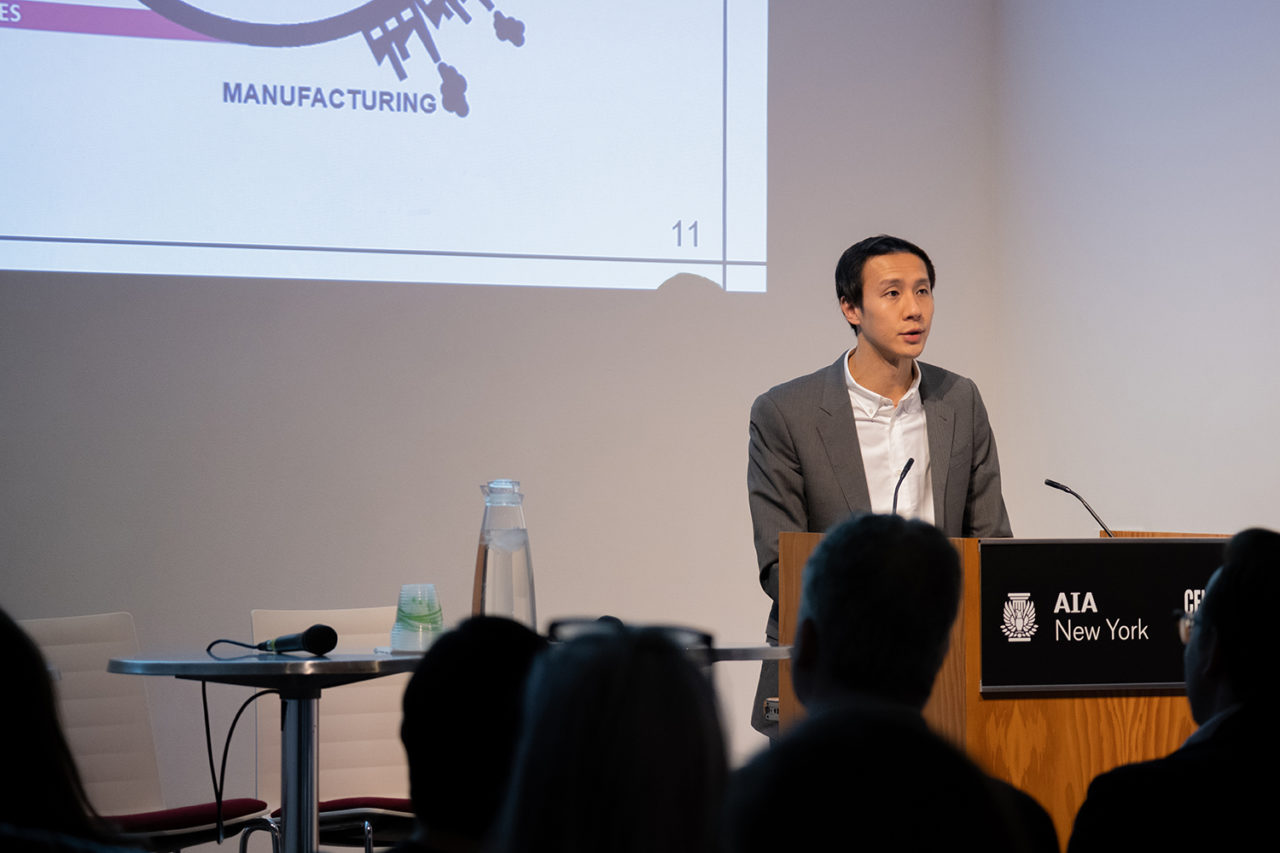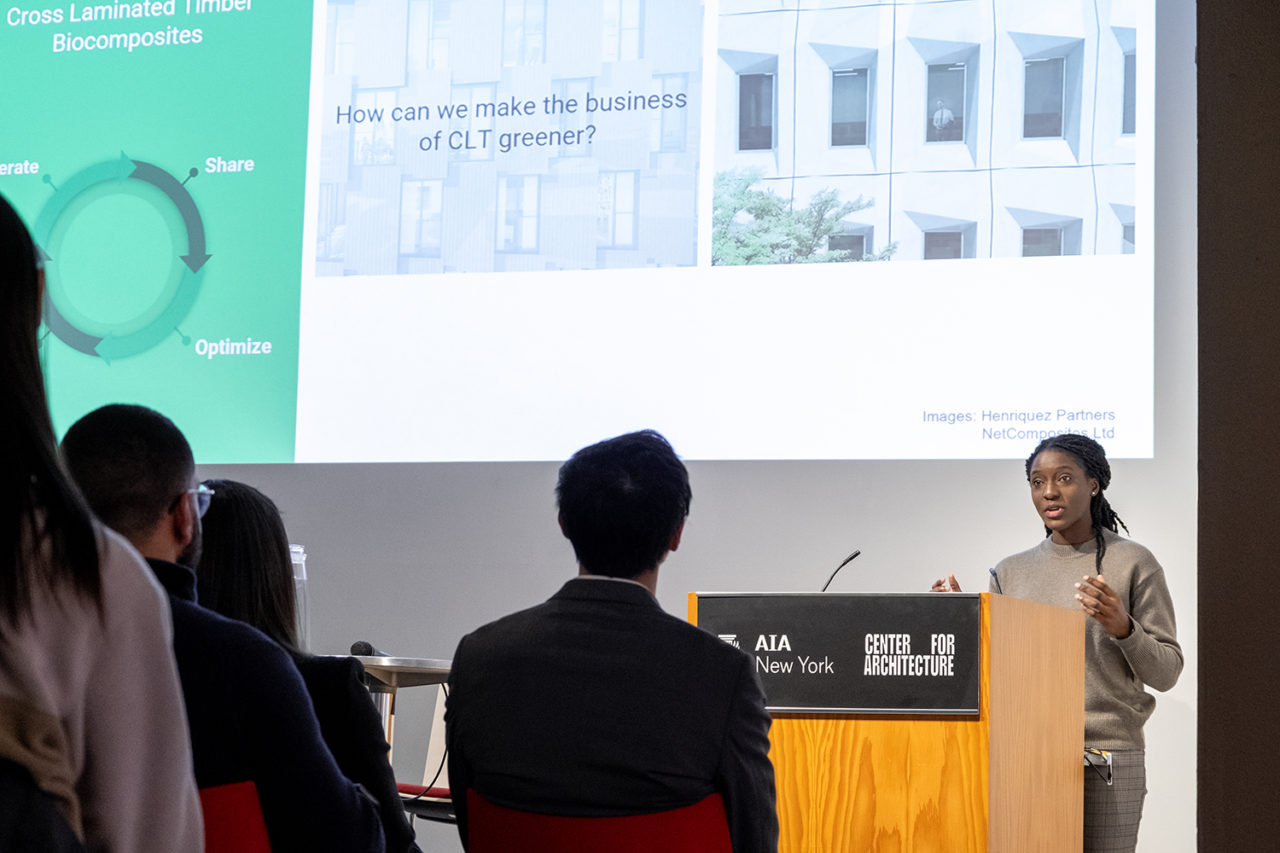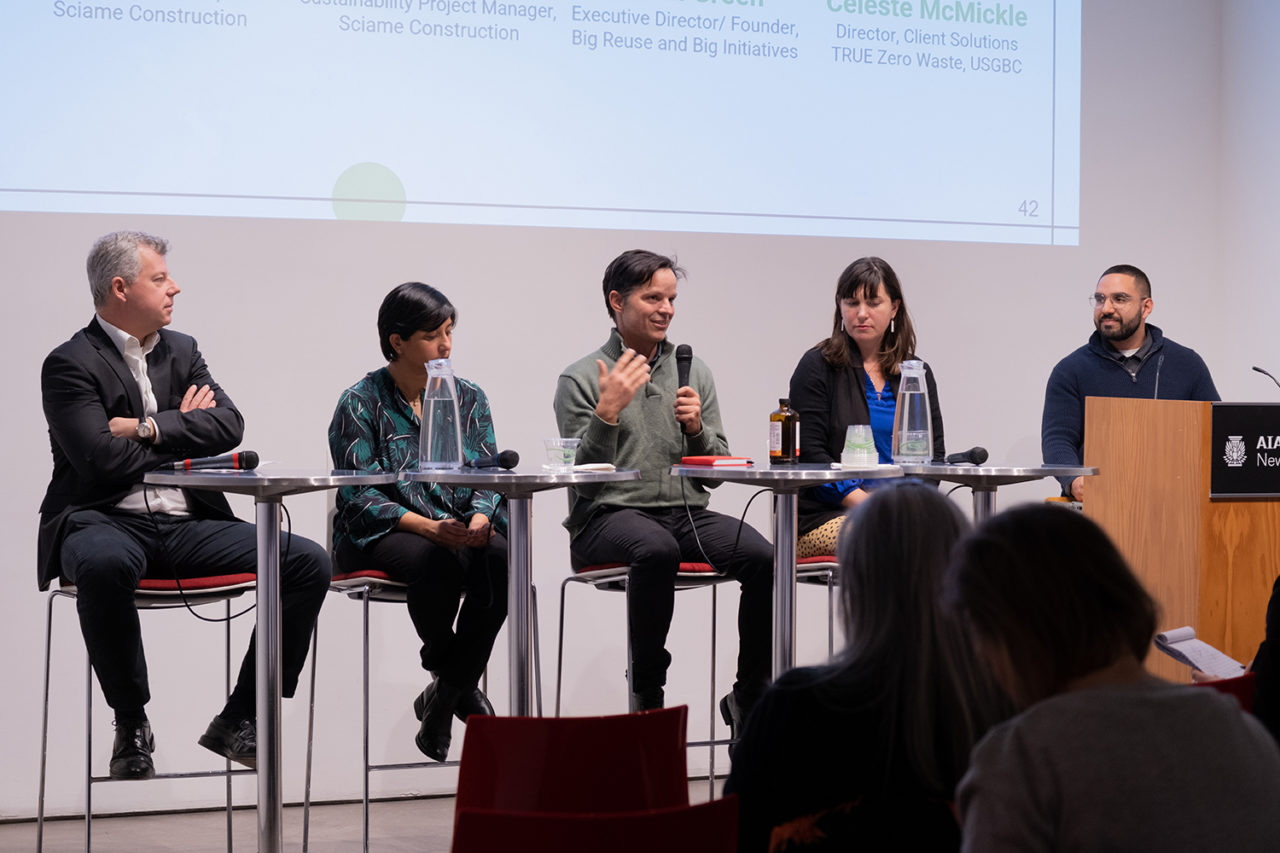by: Tosin Bamidele, Kim Choy, Steven Corsello, Kasey Motley, and Nicolas Savvides
On Thursday, December 1, the 2022 class of the nycoba|NOMA and AIANY Civic Leadership Program (CLP) hosted their second public event titled “Design for Deconstruction: Implementing the Circular Economy in NYC’s Building Sector,” organized by Tosin Bamidele, Kim Choy, Steven Corsello, Kasey Motley, and Nicolas Savvides. The event explored the environmental, financial, and social impacts of construction and demolition (C+D) waste disposal in NYC, as well as options for waste management that enable material circularity.
Background
According to AIANY’s Zero Waste Design Guidelines, New York generates about 7,500 tons of C+D waste every day, amounting to 2.7 million tons a year. Since the closing of the Fresh Kills landfill in 2001, the New York State Department of Conservation has estimated that it exports about 1.6 million tons of this waste, transferring negative externalities of land and air pollution to other states, some as far as Ohio and South Carolina.
Civic Leader Kim Choy opened the conversation with a story about NYC’s poor waste management through the journey of the Mobro 4000 trash barge. Choy then noted how transitioning to a circular economy would allow the city to generate economic as well as social welfare while minimizing ecological impact. Unlike linear models of production, consumption, and disposal, circular systems optimize value and embodied carbon preservation through the continual reuse of materials, products, or components after a project’s lifecycle. This is important in the building industry, especially since construction materials all have different life cycles. Moreover, a circular economy shifts the onus of natural restoration and preservation back onto ourselves, making take care of our own “waste”.
Circularity in the Built Environment
In her section of the presentation, Kasey Motley defined the circular economy and explained how it applies to the built environment, specifically focusing on C+D waste. Motley walked through three strategies found in the Zero Waste Design Guidelines to develop a circular economy in the built environment including (1) designing for material optimization, (2) material selection, and (3) waste management planning. The instruments by which to implement these strategies ranged from technologies such as ARUP’s Circular Building Toolkit to policy and guidelines such as NYC’s Executive Order 23, which mandates the reduction of embodied carbon for municipal construction projects.
Case Studies
Following Motley’s presentation on circularity, Tosin Bamidele discussed examples of designing for deconstruction in the built environment. Bamidele discussed the various scales of application, ranging from products to buildings and cities, highlighting components like cross-laminated timber (CLT) and BioBuild from the European Commission. She discussed scaling up design for deconstruction in buildings and cities, using the Taisugar Circular Village in Taiwan as an example. Two key questions Tosin posed to the audience included: How can designing for deconstruction open up conversations between the C+D industry and other sectors about a more sustainable supply chain? In what ways can all stakeholders begin to rethink usership in order to reduce waste?
Barriers to Implementation
The presentation was wrapped up by Steven Corsello, who spoke about the primary barriers to designing for deconstruction: the time and cost related to designing, separating, and reusing C+D waste. Corsello also emphasized limitations in current markets for salvaged materials and the challenges in identifying reusable components. While designing for deconstruction is being mandated in other cities, such as Palo Alto, CA where demolition has been banned, the lack of consistent federal or international standards for reporting design for deconstruction opportunities leads to a lack of parity across jurisdictions.
Discussion of Circularity in NYC
Moderated by Nicolas Savvides, the discussion portion of the evening invited industry leaders to debate how New York City can adopt a more circular economy in the built environment. The event welcomed Robert Daros, Vice President at Sciame Construction; Pradnaya Narayanan, Project Manager at Sciame Construction; Justin Green, Executive Director and Founder of Big Reuse; and Celeste McMickle, Director of Client Solutions for TRUE Zero Waste at the U.S. Green Building Council (USGBC).
The panel began with an introduction from Daros and Narayanan on how waste segregation manifests itself on a construction site and how practices are influenced by client desire and economic incentives. Daros and Narayanan spoke about how legislation and guidelines, such as LEED certification and the TRUE Zero Waste Construction Pilot, have aided in large-scale changes to waste management on their projects. McMickle spoke of her work with USGBC and highlighted the importance of circularity not only at the construction and deconstruction phases but also at the design phase, where architects make decisions on what will be built. On the policy side, Green emphasized how local action can spark innovation in manufacturing, as seen in hallmark recycling processes such as paper recycling on Staten Island and latex-based paint collection across NYC. Green also talked about deconstruction ordinances already in place in other states such as Portland, Seattle, and San Antonio.
During the Q+A session, the panelists emphasized downstream waste disposal and urged more action around upstream solutions to material reuse in the future, like the direct reuse of large-scale building components and manufacturer buyback programs. They conceded that while it has been long said that “the most sustainable building is the building that already exists,” existing buildings in New York City were not originally built with deconstruction in mind. The panelists encouraged architects to be cognizant of the lifecycle of the buildings they create and to share knowledge within the field as well as grow their material science awareness. The session wrapped up with an emphasis on the architect’s power to address an industry-wide behavioral change, one that currently has an affinity for mass waste.
Key Takeaways
An industry shift is needed to rethink C+D waste and recognize its potential utilization as a resource with a new lifecycle. This shift would allow for a reduced depletion of natural resources and associated embodied carbon. Circularity is an opportunity for all stakeholders to save costs while taking responsibility for the actions of our profession. By opening the discussion to leaders from various fields, the event offered new perspectives on how circularity can be embedded into policy, processes, and practice, emphasizing the importance of cross-disciplinary collaboration in planning for building C+D waste.
Special thanks to:
Christina Brown, CLP Advisor, AIANY
Robert Daros, Vice President, Sciame Construction
Alicia Laryn French, CLP Advisor, AIANY
Justin Green, Executive Director/ Founder, Big Initiatives
Yarden Harari, Senior Associate, CallisonRTKL
Felix Heisel, Director, Cornell Circular Construction Lab
Andrea Kahn, Architect and Founder, designCONTENT
Allison Lane, CLP Advisor, AIANY
Kavitha Mathew, AIA, Special Projects Director, AIANY
Celeste McMickle, Director, Client Solutions TRUE Zero Waste, USGBC
Suzanne Mecs, Hon. AIANYS, Managing Director, AIANY
Clare Miflin, Founder, Center for Zero Waste Design
Pradnaya Narayanan, Project Manager, Sciame Construction
Ben Prosky, Assoc. AIA, Executive Director, AIANY | Center for Architecture
Jenna Wandishin, Program Executive, NYC Department of Design + Construction













